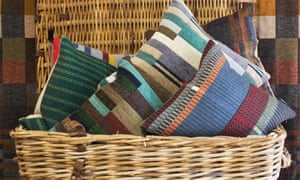
If you happen to be travelling in London soon, take the Bakerloo, Northern or Jubilee tube lines and try to spot the four landmarks embedded in the fabric pattern on the seats. Peer hard enough and you’ll see subtle renditions of the London Eye, Big Ben and Tower Bridge.
These are just some of the many moquettes created for Transport for London by textiles duo Harriet Wallace-Jones and Emma Sewell, who have been designing together as Wallace Sewell for the past 25 years. They have also created fabrics for the Overground, Croydon tram and the new Crossrail. “For the first few Crossrail trains, which are running now, we rode the line and took lots of pictures of buildings and stations,” says Sewell. “There was a shed on the side of the track that was a beautiful grey-green colour, and that ended up as part of the design.” She still feels proud whenever she catches the tube to their north London studio.
Since teaming up in 1992, the pair have designed cushions, rugs and throws for the Tate, West Elm and Anthropologie, among others. They have even recreated Jimi Hendrix’s bedspread for his former London house (now a museum). What unites their work is a love of colour. “We’re very choosy about it,” says Wallace-Jones. “Every year we have an artist whose work we refer to at the start of a new collection.” David Hockney has inspired their spring/summer 2018 scarves; other recent influences include Robert Diebenkorn and Korean artist Chung Eun Mo.
They met while studying textiles at Central School of Art (now Central Saint Martins), but only really became friends during their MA in woven textiles at the Royal College of Art. “There were 15 people in our year, so we became quite a close group. We still have meet-ups,” says Sewell. Then, in 1992, they set up a stand together at the Chelsea Crafts Fair, making their own scarves but trading under the Wallace Sewell name. “An accessories buyer from Barneys in New York came to scout the show and put in an order for scarves. She came back six months later and asked what we were doing for the next season,” says Sewell. “Our accountant said, ‘Why don’t you just become a partnership? It would be simpler for the books.’”

From the start, they knew they wanted to design on hand looms, but have the fabrics woven in industrial mills. “Emma and I are influenced by Bauhaus, which is very much that ethos of hand craft coupled with industrial production,” says Wallace-Jones. They chose the UK so they could be more hands-on. “We were trying to push the limits of what could be done, both with the types of thread we wanted and using multi-colours in the warp. It was quite complicated,” says Sewell.
After trying a number of mills across the north of England, they settled on Mitchell Interflex, a fourth-generation, family-run, 18th-century mill. It has been weaving their fabrics for the past 17 years.
It’s a busy time for Wallace Sewell: as well as Crossrail, they are launching their first collection of rugs at the London Design Festival this month and, to celebrate their quarter-century milestone, preparing for an exhibition opening at the Fashion and Textile Museum in October.

“Nine years ago, I moved from London to Dorset; so now we split the collection, designing individually on our own hand looms, then meeting up once a week to discuss everything,” says Wallace-Jones. “We realise in our dotage that it’s nice we’re not together all the time, and there’s always a fresh eye looking at the work.” They also go camping together with their families once or twice a year, all over the UK.
One of the secrets to their success is that they are completely honest about each other’s designs. “We might disagree a little about something, but I think that’s because we trained together and have worked so closely together for such a long time we almost pick the same colours,” says Sewell. “We have evolved our style together.”
Wallace-Jones agrees. “We’ve never had a row; we’re a bit like a married couple and finish each other’s sentences.” Indeed, one will take over from the other midway through a subject.
Looking ahead, Sewell would like to “go back to my roots and do some beautifully woven fashion fabrics”, while Wallace-Jones is keen on colour consulting. Which means whatever the future holds, it will be bright.
• See Wallace Sewell’s work at designjunction, 21-24 September, Granary Square, London N1; Wallace Sewell: 25 Years of British Textile Design, Fashion and Textile Museum, London SE1, 20 October to 21 January 2018.
Source:-theguardian





